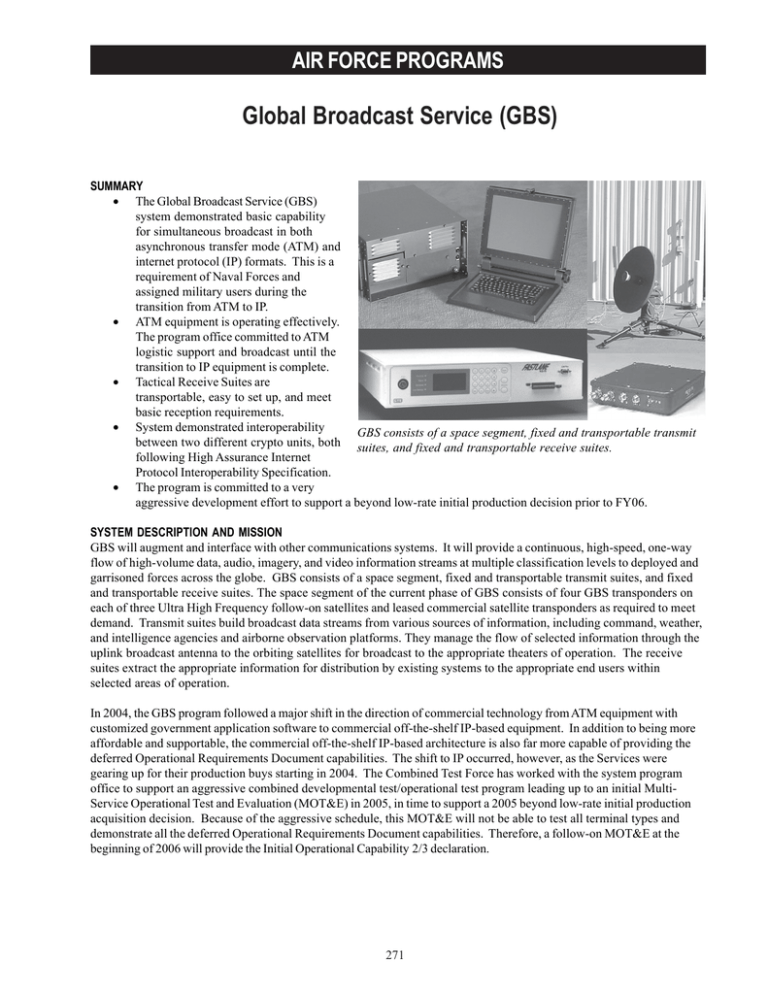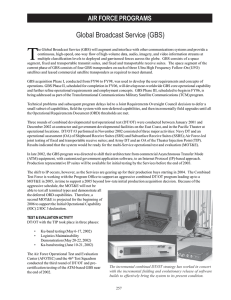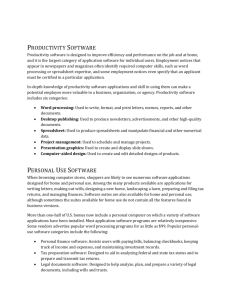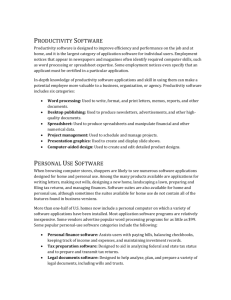Global Broadcast Service (GBS) AIR FORCE PROGRAMS
advertisement

AIR FORCE PROGRAMS Global Broadcast Service (GBS) SUMMARY • The Global Broadcast Service (GBS) system demonstrated basic capability for simultaneous broadcast in both asynchronous transfer mode (ATM) and internet protocol (IP) formats. This is a requirement of Naval Forces and assigned military users during the transition from ATM to IP. • ATM equipment is operating effectively. The program office committed to ATM logistic support and broadcast until the transition to IP equipment is complete. • Tactical Receive Suites are transportable, easy to set up, and meet basic reception requirements. • System demonstrated interoperability GBS consists of a space segment, fixed and transportable transmit between two different crypto units, both suites, and fixed and transportable receive suites. following High Assurance Internet Protocol Interoperability Specification. • The program is committed to a very aggressive development effort to support a beyond low-rate initial production decision prior to FY06. SYSTEM DESCRIPTION AND MISSION GBS will augment and interface with other communications systems. It will provide a continuous, high-speed, one-way flow of high-volume data, audio, imagery, and video information streams at multiple classification levels to deployed and garrisoned forces across the globe. GBS consists of a space segment, fixed and transportable transmit suites, and fixed and transportable receive suites. The space segment of the current phase of GBS consists of four GBS transponders on each of three Ultra High Frequency follow-on satellites and leased commercial satellite transponders as required to meet demand. Transmit suites build broadcast data streams from various sources of information, including command, weather, and intelligence agencies and airborne observation platforms. They manage the flow of selected information through the uplink broadcast antenna to the orbiting satellites for broadcast to the appropriate theaters of operation. The receive suites extract the appropriate information for distribution by existing systems to the appropriate end users within selected areas of operation. In 2004, the GBS program followed a major shift in the direction of commercial technology from ATM equipment with customized government application software to commercial off-the-shelf IP-based equipment. In addition to being more affordable and supportable, the commercial off-the-shelf IP-based architecture is also far more capable of providing the deferred Operational Requirements Document capabilities. The shift to IP occurred, however, as the Services were gearing up for their production buys starting in 2004. The Combined Test Force has worked with the system program office to support an aggressive combined developmental test/operational test program leading up to an initial MultiService Operational Test and Evaluation (MOT&E) in 2005, in time to support a 2005 beyond low-rate initial production acquisition decision. Because of the aggressive schedule, this MOT&E will not be able to test all terminal types and demonstrate all the deferred Operational Requirements Document capabilities. Therefore, a follow-on MOT&E at the beginning of 2006 will provide the Initial Operational Capability 2/3 declaration. 271 AIR FORCE PROGRAMS TEST AND EVALUATION ACTIVITY There were three primary government test events in FY04, each with increasing functionality, complexity, and operational realism. In December 2003, the basic functionality of the commercial off-the-shelf receive suites was tested using commercial off-the-shelf broadcast software and a broadcast generated at the contractor system integration laboratory. The receive suite hardware was similar to the production representative system and did not have crypto equipment. This test identified several issues for resolution and provided sufficient confidence to buy the initial test units. In March 2004, the test was repeated with production representative receive suites, except that the cryptographic equipment was not production representative. The broadcast, run from Wahiawa, Hawaii, used an early version of the government broadcast software, demonstrated end-to-end functionality, and supported the purchase of the low-rate production IP receive suites. In July 2004, following the National Security Agency certification of the production cryptographic equipment, a third test sequence demonstrated full end-to-end performance, with a fully production representative system. The test also demonstrated a simultaneous broadcast of data in both the ATM and IP formats and the ease with which the tactical receive suites can be set up. TEST AND EVALUATION ASSESSMENT The GBS system has made substantial progress from its very elementary capability to a system that played a substantial role in information distribution during both Operation Iraqi Freedom and Operation Enduring Freedom. The incremental integrated developmental test/operational test strategy has worked in concert with the incremental fielding and evolutionary release of software builds to effectively bring the system to its present condition. Testing performed during FY02 and FY03 supported the Initial Operational Capability 1 declaration and Navy baseline of its ATM equipment while identifying the issues that remain to be solved. Performance of ATM equipment. The ATM equipment is effective except for deferred requirements. It is suitable except for reliability of Navy shipboard receive suites. Product reception rates were 96 percent for unclassified data, 93 percent for classified data, and 100 percent for video products – both classified and unclassified. Spot beam control was successful for 100 percent of the requested moves within an average of six minutes. From an operational perspective, the Theater Informational Managers have become integrated into the process. Except as noted, overall reliability, availability, and maintainability is good. The Navy receive suites continue to have a low mean time between operational mean failure. In addition, antenna blockage due to superstructure and other antennas is a Navy-unique problem. Large deck ships with dual antennas have blockage up to 60 degrees and submarines have a blockage from the main periscope of 30 degrees. Preliminary Performance of the IP Equipment. Preliminary results from the testing conducted in FY04 indicate that the IP system is potentially effective and suitable. The new tactical receive suites meet the transportability and weight requirements and can be easily set up in 10 to 15 minutes by an experienced technician – well below the 30 minute requirement. There are numerous issues to be resolved, but the system appears to be capable of meeting the required operational availability and reception rates. Simultaneous broadcast of both ATM and IP formats has been demonstrated but is not yet in the final configuration that will allow greater dynamic allocation of bandwidth. Reliability and maintainability data are not yet available. 272







